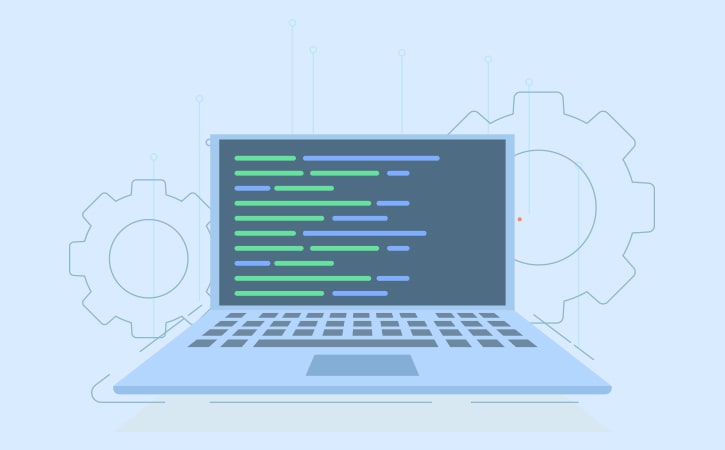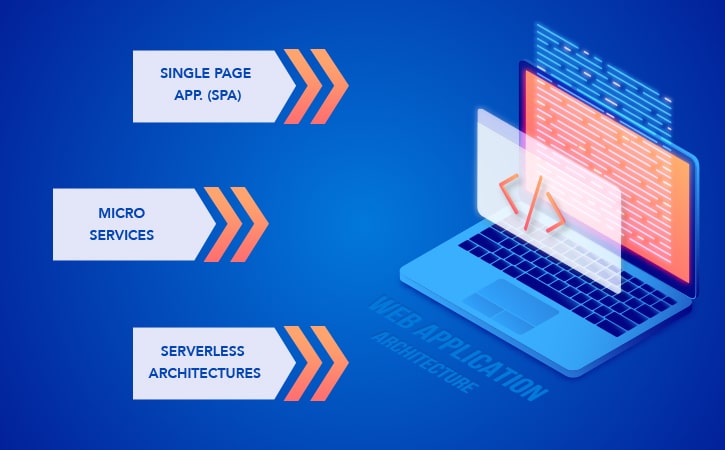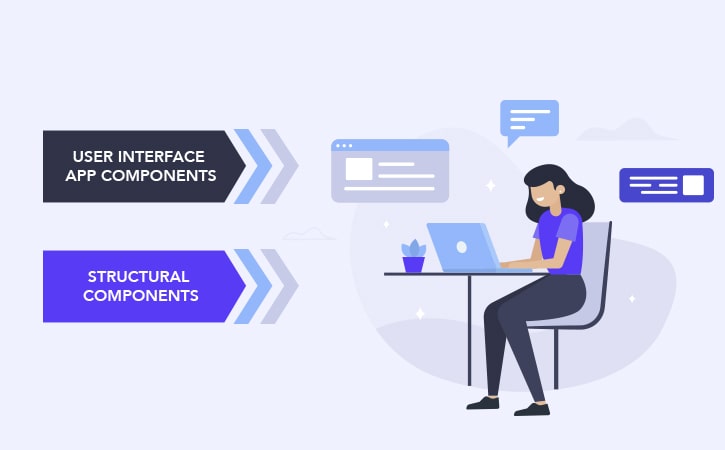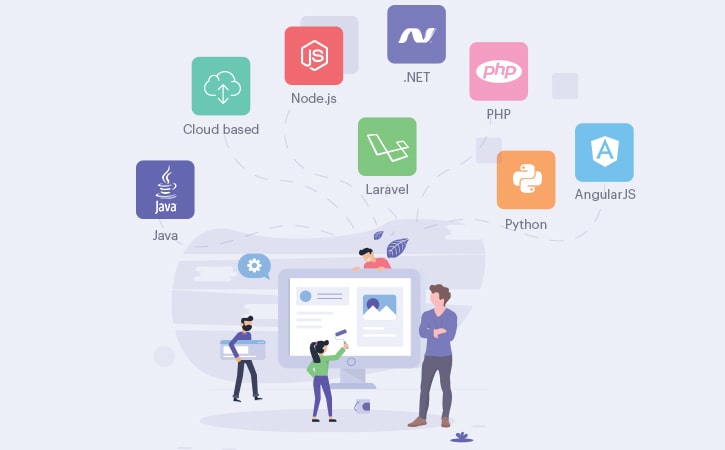
Fundamentals of web application architecture
The average internet user gets to see a specific page on his/her system, through a series of interactions between various components, user interfaces, middleware systems, databases, servers and the browser. The framework which ties up this relation and interaction together is Web application Architecture or web app map. In a nutshell, the flow of processes typically include the user browsing for an URL, following which the browser triggers a search.

Consequent to the search, the network sends data to the browser from the server, and the browser displays the page that has been requested.
To put it quite simply, modern web app architecture includes various components and external apps.
The transition to progressively better mobile and web apps has resulted in transformed capabilities in frontend and backend processes.
With mobile becoming the preferred device for search, the need is for Web app development and architecture that meets requirements across all platforms.
Additionally, multi-page apps are becoming more complex and developers are increasingly veering towards full stack development architecture.
The workings of web app architecture
Web apps include two different sets of programs that run separately yet simultaneously with the shared goal of working harmoniously for delivering solutions.
Typically, the two sets of programs include the code in the browser which works as per the inputs of the user and the code in the server which works as per the requests of protocols, the HTTPS.
In other words, web developers need to be able to decide on the functions of the code on the server and the functions of the code on the browser and how these two will function in relation to each other.
The five types of web app architecture include

Every type of web app component works to create the integral web app, irrespective of its type. Based on a web app’s logical distribution between server-side and client-side, there can be several types of web app architecture that are as follows:
Single page applications (SPA)
It is the era of minimalism, where a single-page web app is more popular. The most sought after applications include only the required elements of content.
This offers a greater interactive user experience, permitting the Single page applications and the user to have a more dynamic interaction.
Microservices
The execution of a single and specific functionality through Microservices Architecture framework permits developers to rollout applications faster and with greater efficiency.
As various components are developed in different coding languages, there is greater flexibility in choosing a technology of choice.
Serverless architectures
A serverless architecture permits the app to execute without a correlation to infrastructure related tasks, where the developers do not have to manage the backend servers, working on third party infrastructure.
Legacy HTML web app
Based on a basic web app architecture, a server that comprises business logic and web page construction logic interacts with the client via a complete web page. To see an update, the user needs to fully reload the page or have the client send a request for an HTML page to the server and load its entire code again.
This type of web app architecture is highly secure as the entire data and logic is stored on the server, which the user can’t access. Because of constant reload and extensive data exchange, it is common for static websites to die out and pave a way towards more agile and interactive web app types.
Widget web app
Here, web services take the place of web page construction logic, and each client page has its separate entities which are known as ‘Widgets”. Widgets receive an enormous amount of HTML or JSON data and display them without reloading the entire page by sending AJAX queries to web services.
Furthermore, the integration of real-time widget updates makes this type more dynamic, mobile-friendly and extremely popular across the customers.
Web app architecture: components
Web Application Architectures comprises various components that are segregated into two categories of components – user interface components and structural components.

User interface app components
This is a reference to the web pages that have a role that is related to the display, settings and configurations.
It is related the interface/experience, rather than the development, and consequently it deals with display dashboards, configuration settings, notifications, and logs etc.
Structural components
The structural components basically refer to the functionality with which a user interacts, the control and the database storage.
In other words, it has got more to do with the structural aspects of the architecture, as the name suggests. This basically comprises (1) The web browser or client, (2) The web application server and (3) The database server.
The web browser or client permits the users to interact with the functions of the web developed with HTML, CSS, and JavaScript.
The web application server handles the central hub that supports business logic and multi-layer applications, developed using Python, PHP, Java, .NET, Ruby, and Node.js.
The database server offers business logic and relevant information/data that is stored and managed by the server. It stores, retrieves and provides the information.

Models of web app components
The model of the web app will depend on the total number of servers and databases used for the design. Below are the models of web app components:
One web server (with database)
One web server with a single database web app component model uses a single server and database. A web app that builds on such a model will go down as soon as the server goes down. That’s why it is unreliable.
Generally, this model is used for running test projects and intending to learn and understand the fundamentals of the web application.
Two+ web servers, one database
In this web application component model, the webserver doesn’t store any data. When the web-server gets information from a client, it writes it to the database after processing. Both these things are managed outside of the server, which is known as stateless architecture.
At least two web servers are needed for this component model to avoid failure. So if one of the web servers goes down, the other one will come to action. All requests will be automatically redirected to the new server so that the web app will continue execution. Hence, reliability is better compared to a single server.
Two+ web servers, two+ databases
This model is the most efficient one. The two servers or multi-server model gives two options to its user where they can store the whole data into employed databases or they can disperse it through these databases.
To store the whole data, the user just needs two databases. But in the case of dispersement, However, the most common thing in both these cases is DBMS normalization. Also, it is advisable to use more than 4 or 5 servers or both to install load balancers.
Web server architecture
By all definitions this refers to the ideal layout of a web server, which will facilitate the design, development and deployment of the web server.

The role is to accede to the requests of clients, including browsers and mobile applications via secure protocols. The requests could pertain to page resources or could also be related to a REST API.
Web servers are intrinsic to the working of web apps, mandating the need for increased emphasis on web server architecture, including the server’s physical capacity – storage, memory, computing power, and performance, apart from the application tier.
This could be anywhere – either inside the server, across the network or the operating systems. The different types of web server architecture include:
Java web application architecture
By virtue of being a versatile programming language, Java web app architecture is popular in the enterprise development environment.
The requirements of a solution determine the complex nature of web application architectures that could be either simple or multi-tiered.
Regardless of the complexity or the nature of the app, Java Web Application Architecture is the preferred platform for developers to build solutions and deliver as per expectations.
One of the distinct advantages of this architecture is the ability to combine and rely on the Java native tools, and frameworks for creating applications.
Cloud based web application architecture
The migration to the cloud is more of an imperative than a choice, primarily as a result of the benefits across all parameters.
Consequently, cloud based web app architecture have been developed, this has resulted in the creation of a corollary – the decoupling of data. In other words, cloud based app function and store information on local servers and the cloud.
Node.js web application architecture
At the core of Node.js web application architecture, lies the pattern of model-view; for instance, the model-view-controller, the model-view-view model and the model-view-presenter.
Node.js permits the creation of patterns for the purpose of identifying code elements, and also to configure the elements, apart from routing.
This relies on an entity-relationship which helps to ensure that the app runs seamlessly, through data systematization, breaking logic into modules, processing valuable insights from logs and dividing the code.
Another important advantage is the fact that Node.js web application architecture helps build scalable web apps.
.NET web application architecture
This handles requirements including cross-platform support, Docker containers, microservices, and side-by-side versioning.
The highlight of this framework is ability to store data without the need for applying database code.
Known as Data Access Layer, it helps improve functionality and development, as the architecture relies on ASP.NET Core and .NET Core for optimization.
PHP web application architecture
By virtue of being the least complex and highly functional development languages, PHP is one of the most popular among the community.
The architecture permits robust security, swift development, a dedicated framework, simple maintenance, and extended support from a community of developers.
AngularJS web application architecture
This architecture works in dual mode for HTML and TypeScript as a platform and also as a framework.
The use of modules for building offers manifold benefits through Angular development, including user experience with tiresome load time, apart from reducing the code size.
Laravel web development
Laravel, another PHP web framework adopts the model view controller architectural pattern, and has at its core syntax that is expressive, creative and elegant.
It offers a simplified web development process through better routing, sessions, authentication, and caching; as a result it takes lesser time for completing projects.
It helps to increase traffic, and incorporates flexible features including modular packaging systems.
One of the highlights, is the fact that different routes can be creates with an existing route name, by creating unique URLs. The auto loading facility dispenses with the need for special inclusion paths.
Python web frameworks
Python facilitates the development of web applications with code that is short/concise, easily readable and maintainable. This is one of the reasons why developers take a fancy to Python for use as a server side scripting language.
Custom web application through Python development is achieved by using multiple Python Web Frameworks, including full stack.
Not only is it dynamic, it does not require lengthy coding, typically reducing coding length by as much as 1/5th of other programming languages.
Perhaps the biggest advantage of Python is that the language is considered as the most suited one for prototyping.
In addition to this, it is highly flexible and integrates well with other languages, apart from the extensive library at its disposal.
Brief overview of three-tier architecture
Three-tier architecture consists of three app tiers – presentation tier, application tier and data tier. The main advantage of the three-tier architecture is that every development team can develop each tier separately. Moreover, web app performance is also improved with this architecture.
The chief benefit of the three-tier architecture is that it is a very clean architecture where each tier runs on one dedicated server hardware or virtual server. Because of this, each tier’s application services can be customized and optimized without impacting the other architectures.
In addition to this, three-tier architecture provides several other benefits such as superfast development, great reliability, enhanced security, and improved scalability.

Web Application Architecture Diagram
Basically, a web application architecture diagram is a framework that facilitates interactions among components. In short, a web app architecture diagram is a client-server app that includes numerous user interfaces, application insights, databases and middleware systems. But the list doesn’t end here, there are a few more:
DNS
Domain Name System or DNS is a key system that helps search IP address and domain name and IP address. And in this manner, a particular server receives a request that is sent by a user. So basically, DNS is an architectural model that is like a phone directory of Internet websites.
Load Balancer
Load Balancer primarily deals with directing incoming requests to any of the multiple servers. Usually, the servers exist as multiple copies, mirroring one another. So that any of the servers processes requests in a similar manner, and the load balancer distributes tasks to prevent them from being overcharged.
Web App Servers
This server component works as an application deployment descriptor that processes a user request and sends JSON or XML documents back to a browser. This usually refers to back-end infrastructures such as cache server, database, and job queue. Besides, at least two servers, connected to the load balancer, process the user’s requests.
Databases
A database offers ample instruments for adding, organizing, updating, searching, deleting, and performing computations. In the majority of cases, the web app servers directly interact with the job servers.
Caching Service
Caching service provides data storage and data search. Whenever a user gets some information from the server, the results are cached. So, future requests return faster.
Caching is effective in the following scenarios:
Wrapping up
As the web evolves, the associated technologies and frameworks evolve alongside. Modern web application development has replaced the older legacy structures and basic components.
It is therefore imperative to choose the right web app architecture which will determine the performance of the web application.
Important parameters hinge on the choice of architecture – the speed of the web app, the robust and secure nature, and the manner in which it is responsive.
The business needs of a solution needs to be viewed in the context of technical needs and vice versa. The right web application architecture paves the way for future plans of expansion and scalability with what can be called as an intelligent blueprint.
Expansion in the future is not just increased demand, but will inevitably include requirements such as interoperability and the need for increased reliability.


Leave a comment: